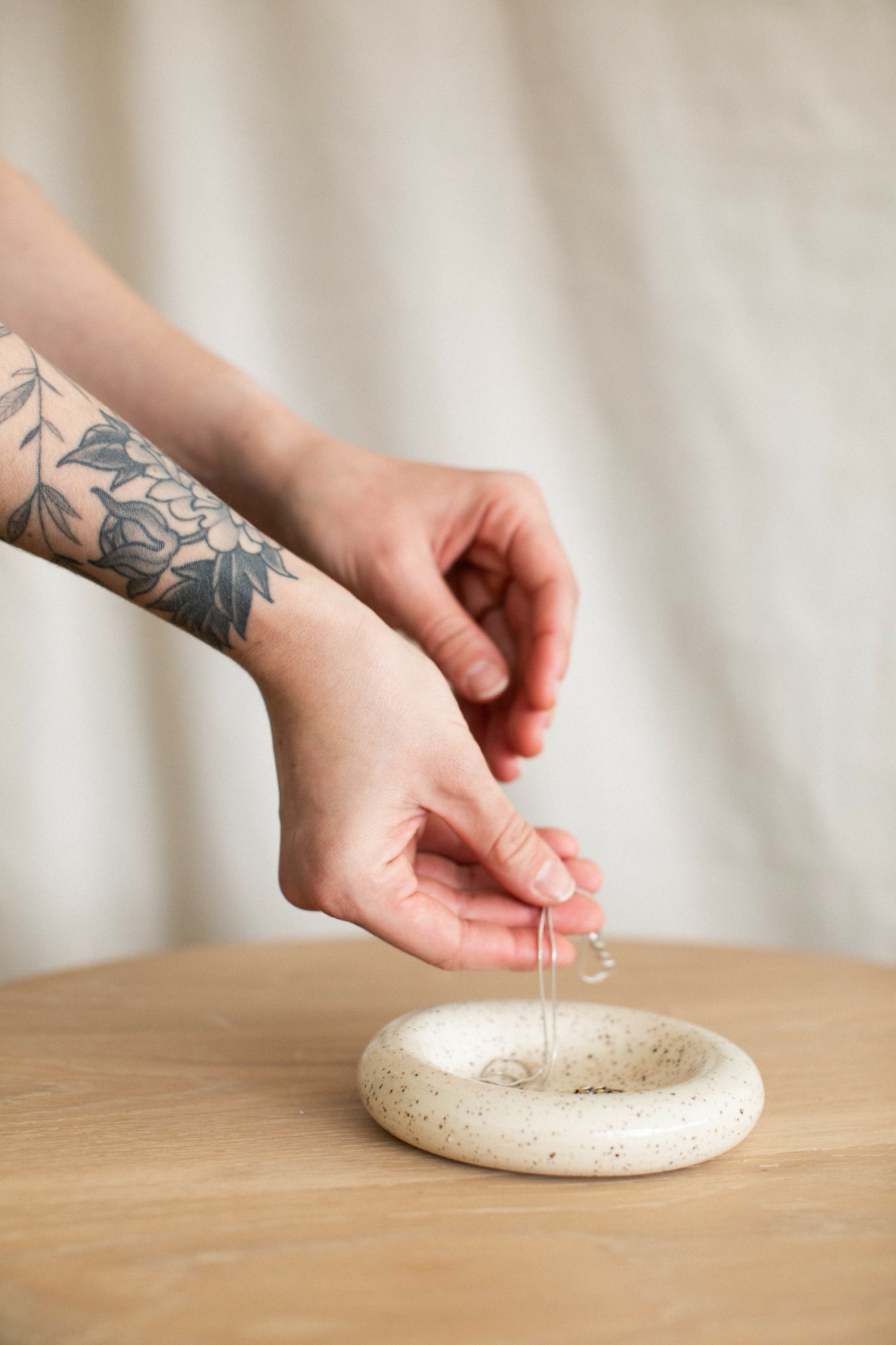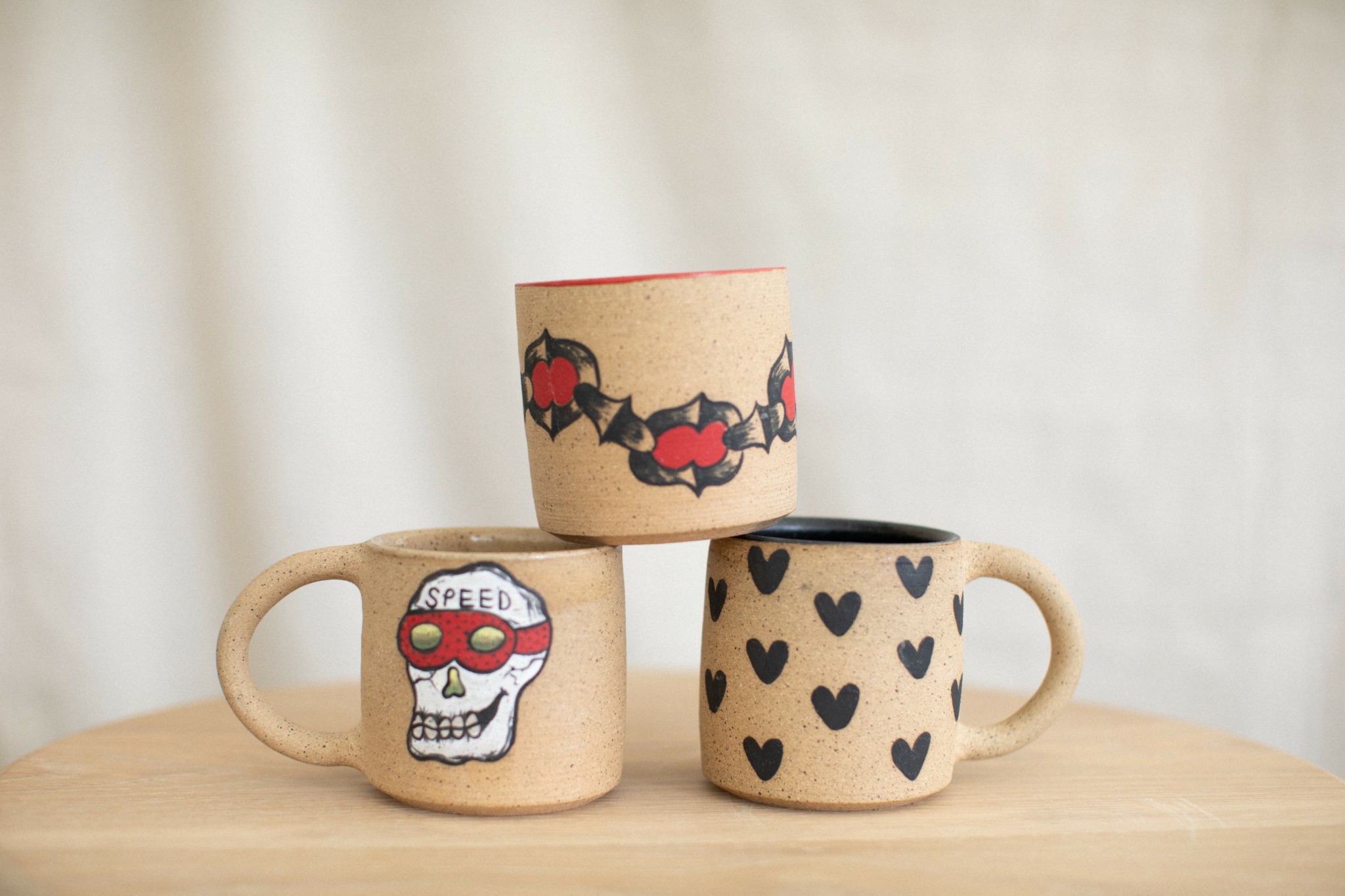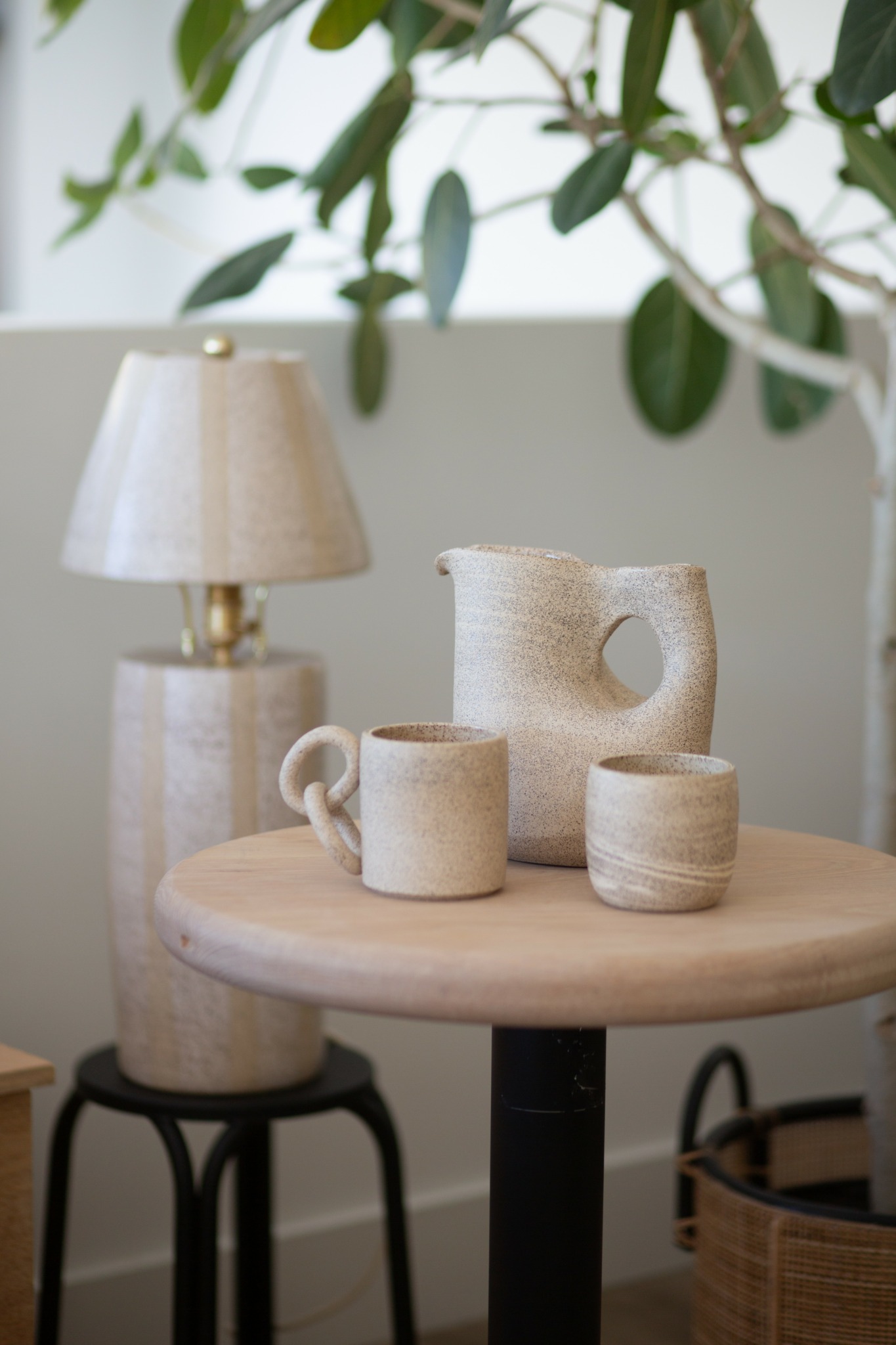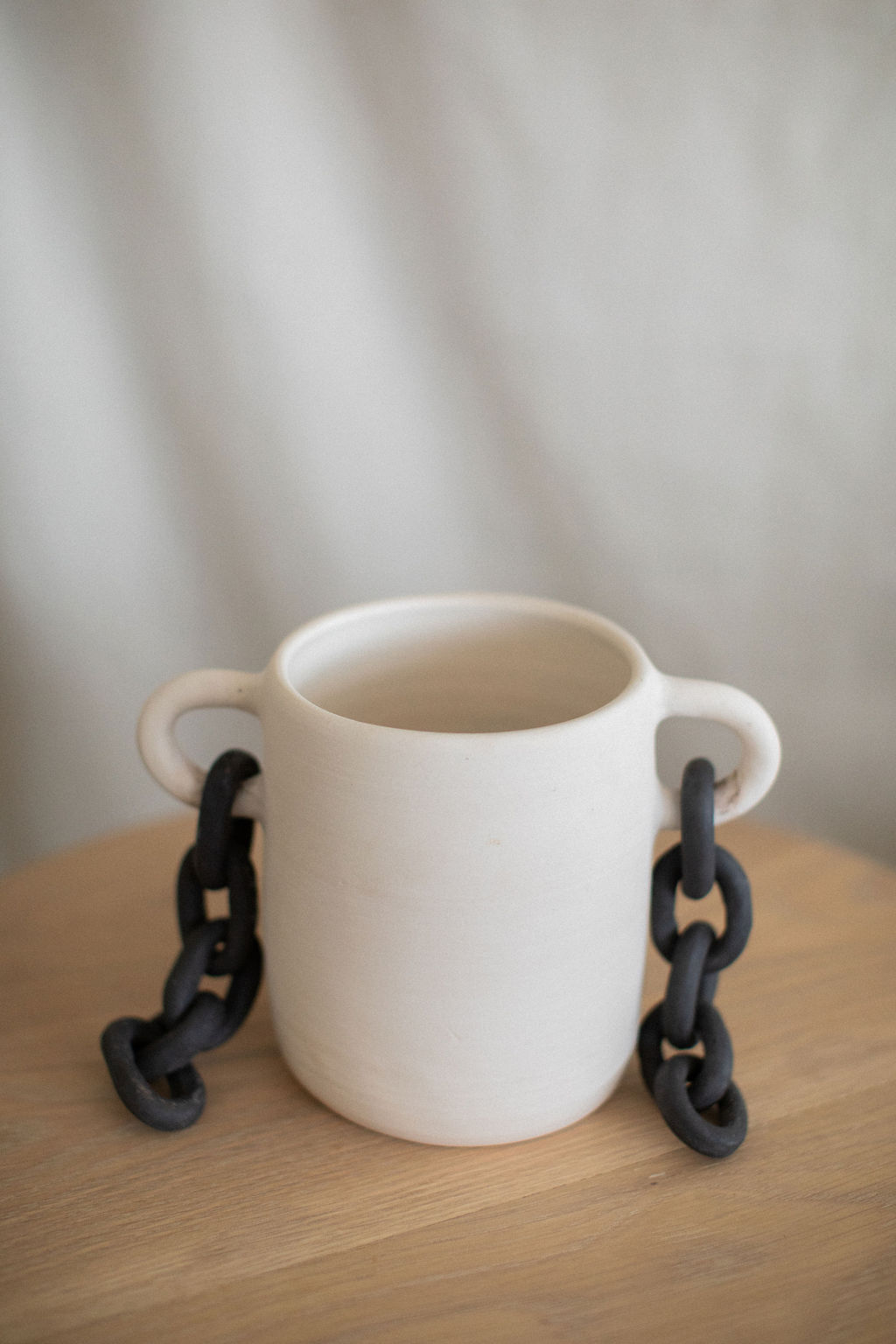We caught up with the brilliant and insightful Holly Buchbinder a few weeks ago and have shared our conversation below.
Holly, thanks for taking the time to share your stories with us today Learning the craft is often a unique journey from every creative – we’d love to hear about your journey and if knowing what you know now, you would have done anything differently to speed up the learning process.
I’ve always been artistic. As a kid, I was constantly drawing and sketching, and as I got older, I became really drawn to American traditional tattoo style. There was a time when I thought I might pursue tattooing. I spent months just drawing flash. Eventually, I realized that dream wasn’t for me, but that process shaped how I approach design, and you can still see that influence in my work.
I had wanted to learn pottery for years but never had the chance. One day, I met a ceramicist at a local art market and ended up signing up for a wheel throwing class with her. I took that one class and, I know it sounds cheesy, but it felt like all the stars aligned. Something just clicked. I thought about it for a few days, but I couldn’t shake the feeling. If anything, I wanted to do it even more. So I ordered my own wheel.
Once it arrived, I threw every chance I got. Every hour I wasn’t working, I was practicing. My wheel was in the corner of my home office, so that made it pretty convenient. At the time, I was really into the look of porcelain with cobalt blue painting, so I only used porcelain for the first few months. If you don’t know much about clay bodies, porcelain is one of the hardest to work with; it’s finicky and unforgiving. Nothing turned out the way exactly how it looked in my head, which somehow just made me want to keep going. Eventually, I switched to a less challenging clay body, and it was like the sun came out. All those hours struggling with porcelain had built my skills and made everything else feel more natural.
I’ve thrown almost every day since that first class. And when I’m not physically making or hand painting my pieces, I’m thinking about pottery.
I think tenacity has been the most essential skill for me. Art can be a natural gift, but that only takes you so far. The only reason I am where I am in my clay journey is because I’ve put in thousands of hours at the wheel. Especially in the beginning, nothing looked the way I wanted it to, but I kept showing up and trying again. Pottery is humbling—it takes patience, repetition, and a willingness to mess up over and over. That persistence is what’s made the biggest difference in my growth.

Awesome – so before we get into the rest of our questions, can you briefly introduce yourself to our readers.
I’m the ceramicist behind hfb ceramics. I make functional pottery, mostly wheel-thrown pieces that are hand-painted and rooted in ritual. I want the things I make to feel personal, to be the kind of objects people reach for every day and build routines around. I think there’s something powerful in using something handmade. It slows you down a little. It makes the ordinary feel a bit more intentional.
I’m a one-person studio, so I do everything from making and trimming the pieces to hand painting, glazing, firing, photographing, and shipping. I also teach classes, which is one of my favorite parts of this work. My students range from total beginners to people who’ve been throwing for years but want to work on specific skills. Teaching is a way for me to share what I’ve learned (mostly through trial and error), and it gives me energy and inspiration to be around people who are excited about clay.
What sets my work apart is the way I balance function and detail. Every piece I make is meant to be used, but I also spend time on design. Whether that’s a hand-painted flash piece or a specific curve or handle placement that feels good in your hand. I want people to find beauty in the small things.
I’m most proud of the consistency I’ve built—of showing up day after day to do the work. Pottery has taught me a lot about patience, persistence, and learning through failure. I want people who interact with my work to feel that sense of care and thoughtfulness, whether they’re drinking coffee out of one of my mugs or learning to center clay for the first time.
Additionally, I am opening a brick and mortar studio in Cleveland, OH this month! This has been a huge undertaking but I am so excited to create more of a community here.

In your view, what can society to do to best support artists, creatives and a thriving creative ecosystem?
I think one of the best ways society can support artists is by simply showing up. That alone makes a huge difference. If you have a friend who’s just starting to sell their work at markets, go. Even if you’re not buying anything, just showing up, looking at what they’ve made, asking questions, and taking it in. That kind of support matters more than people realize. It helps build confidence, and it reinforces that what they’re doing has value.
Support doesn’t always have to be financial. Sharing someone’s work, talking about it, or just encouraging them to keep going are all real ways to support artists. Creative work can feel isolating, and having people engage with what you’re doing, even in small ways, makes you feel seen. That’s huge.
On a broader level, I think we also need to shift the mindset that art is extra or optional. Art is part of daily life and it shapes how we interact with the world. Prioritizing space for it, both physically and culturally, is something we all benefit from.

Is there a particular goal or mission driving your creative journey?
When it comes to teaching, my goal is to challenge the idea that someone is “just bad at art.” I hear that a lot, and honestly, I think it’s either something people say when they haven’t found their niche yet, or something they’ve been told somewhere along the way that stuck with them. I don’t think being creative is reserved for a select few. My job as an instructor is to help people unlearn that kind of thinking. I try to create a space where people can experiment, mess up, try again, and find their way into the process because that’s what art really is.
Contact Info:
- Website: https://hfbceramics.com/
- Instagram: https://www.instagram.com/hfbceramics/
- Other: https://www.tiktok.com/@hfbceramics



Image Credits
Mary McLeod


